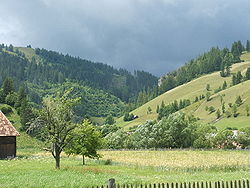Lunca de Jos
|
Lunca de Jos Gyimesközéplok |
|
|---|---|
| Commune | |
 |
|
 Location of Lunca de Jos |
|
| Location of Lunca de Jos | |
| Coordinates: 46°34′0″N 25°59′0″E / 46.56667°N 25.98333°ECoordinates: 46°34′0″N 25°59′0″E / 46.56667°N 25.98333°E | |
| Country |
|
| County | Harghita County |
| Status | Commune |
| Government | |
| • Mayor | Péter Mihók (Independent) |
| Area | |
| • Total | 59.06 km2 (22.80 sq mi) |
| Elevation | 930 m (3,050 ft) |
| Population (2011) | |
| • Total | 5,265 |
| • Density | 89/km2 (230/sq mi) |
| Ethnicity | |
| • Hungarians | 99.2% |
| • Romanians | 0.78% |
| Time zone | EET (UTC+2) |
| • Summer (DST) | EEST (UTC+3) |
| Postal Code | 537145 |
| Area code(s) | +40 266 |
Lunca de Jos (Hungarian: Gyimesközéplok, Hungarian pronunciation: [ˈɟimɛʃkøzeːplok], colloquially Középlok) is a commune in Harghita County, Transylvania, Romania. It lies in the ethno-cultural region Szekely land.
The commune is composed of nine villages:
The village was historically part of the Székely Land region of Transylvania province. The first peports of settlers in the area was from 1721. It became independent from Gyimesbükk in 1795. The birth registry starts from 1854. The village belonged to Csíkszék district until the administrative reform of Transylvania in 1876, when they fell within the Csík County in the Kingdom of Hungary. After the Treaty of Trianon of 1920, they became part of Romania and fell within Ciuc County during the interwar period. In 1940, the second Vienna Award granted the Northern Transylvania to Hungary and the villages were held by Hungary until 1944. After Soviet occupation, the Romanian administration returned and the commune became officially part of Romania in 1947. Between 1952 and 1960, the commune fell within the Magyar Autonomous Region, between 1960 and 1968 the Mureș-Magyar Autonomous Region. In 1968, the province was abolished, and since then, the commune has been part of Harghita County.
The commune has an absolute Hungarian (Székely and Csángó) majority. According to the 2011 census it has a population of 5,265 of which 99.2% or 5,223 are Hungarian.
...
Wikipedia

